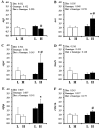Effects of Diets with Different Proportions of Protein/Carbohydrate on Retinal Manifestations in db Mice
- PMID: 29475908
- PMCID: PMC5905193
- DOI: 10.21873/invivo.11233
Effects of Diets with Different Proportions of Protein/Carbohydrate on Retinal Manifestations in db Mice
Abstract
Background/aim: Diabetic nephropathy is aggravated by a higher intake of total protein. The effects of diets with different proportions of protein and carbohydrate on diabetic retinopathy in db mice, a type-2 diabetes animal model, were examined, as well as diabetic nephropathy.
Materials and methods: Control and db mice at 5 weeks of age were fed the diets (% energy of protein/carbohydrate/fat; L-diet: 12/71/17; H-diet: 24/59/17) under ad libitum conditions and pair-feeding conditions for 6 weeks, respectively.
Results: Mice fed the H-diet showed significantly greater retinal thickness by optical coherence tomography, and lower mRNA levels of angiotensinogen. Comparing combinations of diets and genotypes, db-H mice showed significantly higher mRNA levels of angiotensin-converting enzyme, advanced glycosylation end product-specific receptor, and cluster of differentiation molecule 11b (a microglial marker) than db-L mice.
Conclusion: Dietary protein and carbohydrate proportions influenced retinal manifestations, including retinal thickness and gene expression in control and diabetic mice.
Keywords: db Mice; diabetic retinopathy; optical coherence tomography; renin-angiotensin system.
Copyright© 2018, International Institute of Anticancer Research (Dr. George J. Delinasios), All rights reserved.
Figures


Similar articles
-
Higher Branched-chain Amino Acids and Lower Serine Exist in the Plasma of Nondiabetic Mice: A Comparison Between High- and Low-protein Diet Conditions.In Vivo. 2021 May-Jun;35(3):1555-1560. doi: 10.21873/invivo.12410. In Vivo. 2021. PMID: 33910835 Free PMC article.
-
Low-protein diet improves blood and urinary glucose levels and renal manifestations of diabetes in C57BLKS-db/db mice.Eur J Nutr. 2013 Mar;52(2):813-24. doi: 10.1007/s00394-012-0387-4. Epub 2012 Jun 13. Eur J Nutr. 2013. PMID: 22692501
-
Deteriorated glucose metabolism with a high-protein, low-carbohydrate diet in db mice, an animal model of type 2 diabetes, might be caused by insufficient insulin secretion.Eur J Nutr. 2017 Feb;56(1):237-246. doi: 10.1007/s00394-015-1075-y. Epub 2015 Oct 24. Eur J Nutr. 2017. PMID: 26497335
-
BTBR ob/ob mouse model of type 2 diabetes exhibits early loss of retinal function and retinal inflammation followed by late vascular changes.Diabetologia. 2018 Nov;61(11):2422-2432. doi: 10.1007/s00125-018-4696-x. Epub 2018 Aug 9. Diabetologia. 2018. PMID: 30094465 Free PMC article.
-
Effect of dietary carbohydrate, fat, and protein on postprandial glycemia and energy intake in cats.J Vet Intern Med. 2013 Sep-Oct;27(5):1121-35. doi: 10.1111/jvim.12139. Epub 2013 Jul 19. J Vet Intern Med. 2013. PMID: 23869495 Clinical Trial.
Cited by
-
Effects of the amount and type of carbohydrates used in type 2 diabetes diets in animal models: A systematic review.PLoS One. 2020 Jun 12;15(6):e0233364. doi: 10.1371/journal.pone.0233364. eCollection 2020. PLoS One. 2020. PMID: 32530969 Free PMC article.
-
Higher Branched-chain Amino Acids and Lower Serine Exist in the Plasma of Nondiabetic Mice: A Comparison Between High- and Low-protein Diet Conditions.In Vivo. 2021 May-Jun;35(3):1555-1560. doi: 10.21873/invivo.12410. In Vivo. 2021. PMID: 33910835 Free PMC article.
-
Nutritional Risk Factors in Albuminuria and Retinopathy in Patients Newly Diagnosed With Type 2 Diabetes: A Cross-sectional Case Series Study.In Vivo. 2024 Sep-Oct;38(5):2506-2514. doi: 10.21873/invivo.13722. In Vivo. 2024. PMID: 39187356 Free PMC article.
-
Increased Expression of Ecto-NOX Disulfide-thiol Exchanger 1 (ENOX1) in Diabetic Mice Retina and its Involvement in Diabetic Retinopathy Development.In Vivo. 2019 Nov-Dec;33(6):1801-1806. doi: 10.21873/invivo.11671. In Vivo. 2019. PMID: 31662505 Free PMC article.
-
Optimizing diabetic kidney disease animal models: Insights from a meta-analytic approach.Animal Model Exp Med. 2023 Oct;6(5):433-451. doi: 10.1002/ame2.12350. Epub 2023 Sep 18. Animal Model Exp Med. 2023. PMID: 37723622 Free PMC article. Review.
References
-
- Cruickshanks KJ, Ritter LL, Klein R, Moss SE. The association of microalbuminuria with diabetic retinopathy: The Wisconsin Epidemiologic Study of Diabetic Retinopathy. Ophthalmology. 1993;100:862–867. - PubMed
-
- Zimmet P, Alberti KG, Shaw J. Global and societal implications of the diabetes epidemic. Nature. 2001;414:782–787. - PubMed
-
- Sone H, Katagiri A, Ishibashi S, Abe R, Saito Y, Murase T, Yamashita H, Yajima Y, Ito H, Ohashi Y, Akanuma Y, Yamada N, JD Study Group. Effects of lifestyle modifications on patients with type 2 diabetes: the Japan Diabetes Complications Study (JDCS) study design, baseline analysis and three year-interim report. Horm Metab Res. 2002;34:509–515. - PubMed
MeSH terms
Substances
LinkOut - more resources
Full Text Sources
Other Literature Sources
Medical
Miscellaneous
